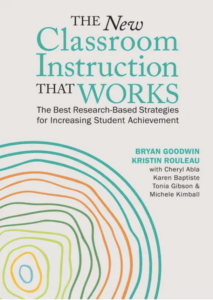The All-New ‘Classroom Instruction That Works’
The New Classroom Instruction That Works: The Best Research-Based Strategies for Increasing Student Achievement
By Bryan Goodwin and Kristin Rouleau (with Cheryl Abla, Karen Baptiste, Tonia Gibson, and Michele Kimball)
(ASCD, 2023 – Learn more)
Reviewed by Hannah Mickey

To many, the traditional classroom is comprised of homework, lectures, and tests. Goodwin, Rouleau and their colleagues debunk this structure and, using science, explore how students – and human beings – actually learn.

I didn’t know what research-based practices were. I knew instructional strategies, but I had no idea about the “why” behind them. The third edition of Classroom Instruction That Works can change that for future generations.
Looking into why the strategies work
For any experienced teacher, there will be some familiar concepts in the book, such as goal-setting, Frayer models, higher-level questions, and think-pair-share. However, the authors go further than explaining what the strategies are by also explaining why the strategies work.
The text succinctly captures researched-based strategies for any and every classroom. The book is organized into six main chapters that represent the phases of learning:
- Helping Students Become Interested in Learning
- Helping Students Commit to Learning
- Helping Students Focus on New Learning
- Helping Students Make Sense of Learning
- Helping Students Practice and Reflect
- Helping Students Extend and Apply Learning
Each of the six chapters is structured the same way. First, the authors present a review of the literature, then strategies based on the literature, and finally tips for implementation of strategies in real classrooms.
Research of diverse grade levels, subject areas, and student populations
The authors have done much of the hard work for teachers by investigating what the literature says. Included in the appendix is a list of every research study that the authors reference. The research was not limited to one level or subject area; rather, the literature reviewed covered a diverse set of grade levels, subjects, and student populations.
I appreciated the variety of sources cited and the examples given. Any teacher could find examples that fit their grade level or specific content. However, I would love to see a series of books that take the information from The New Classroom Instruction That Works and applies it to each of the four core content areas. Perhaps that is in the works.
In total, the book features 14 different strategies teachers can integrate into their classrooms, spread throughout the six chapters:
- Cognitive Interest Cues
- Student Goal Setting
- Vocabulary Instruction
- Instruction and Modeling
- Visualizations and Concrete Examples
- High-Level Questions and Student Explanations
- Guided Initial Application with Formative Feedback
- Peer-Assisted Consolidation of Learning
- Retrieval Practice
- Spaced, Mixed Independent Practice
- Targeted Support
- Cognitive Writing
- Guided Investigations
- Structured Problem Solving
Goodwin, Rouleau and their co-authors walk readers through how to use each of these strategies with concrete examples, making it easy for teachers to transfer the strategies into their practice. The strategies provided are a mix of old and new.
If you are familiar with previous versions of Classroom Instruction That Works, then you will appreciate the crosswalk included in Figure 7.1, which outlines the original strategy presented and how it aligns with the new strategies.
One helpful addition to the third edition is the chapter on targeted support. When I was an English language arts teacher, I focused on small-group targeted intervention. Now that I have moved grade levels and subject areas, I am having to reimagine what targeted support looks like in my classroom.
For teachers and beyond
This book is great for teachers, but it is also a valuable tool for coaches and educator preparatory programs. Coaches could lead a book study and have teachers they are working with choose an area to work on from this text. Additionally, this resource could be the foundation for lesson planning by pre-service teachers in educator preparatory programs.
As I plan my lessons and continue to support beginning teachers, I will be pulling this book out for inspiration.
Hannah Mickey is certified in secondary English language arts and social studies. She currently teaches high school US history in North Carolina. Hannah completed her undergraduate studies with a Bachelor’s in Education from the University of North Carolina at Chapel Hill. She received a Master’s in Curriculum and Instruction from Appalachian State University in 2022. As an instructional leader at her school, Hannah loves mentoring new teachers and improving her own practices. You can find her on Instagram @msmickeysmuseum.






























